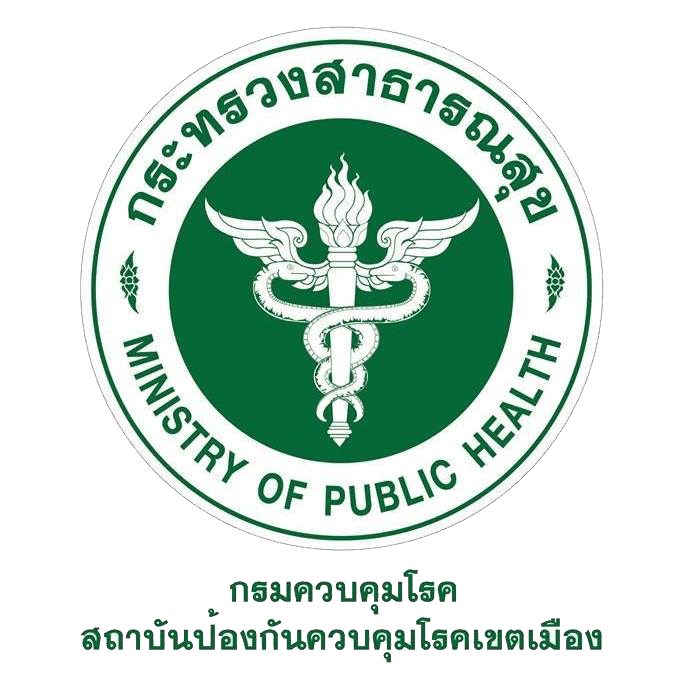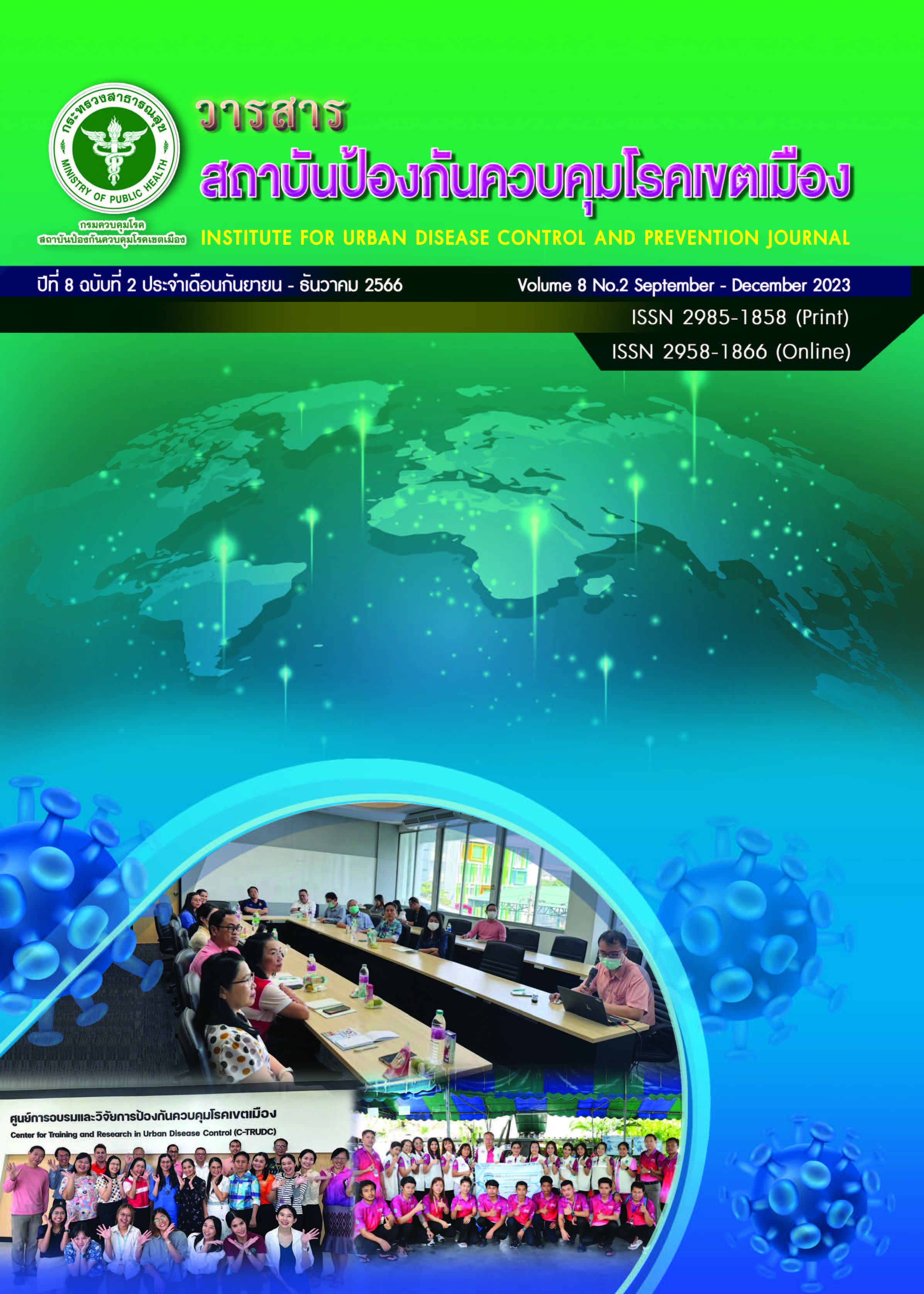ปัจจัยที่มีความสัมพันธ์กับความสำเร็จในการรักษาวัณโรคปอด ในกลุ่มประชากรผู้สูงอายุ กรุงเทพมหานคร
Main Article Content
บทคัดย่อ
ปัจจุบันวัณโรคปอดมีอัตราป่วยและเสียชีวิตเพิ่มสูงขึ้นต่อเนื่องในกลุ่มผู้สูงอายุ โดยเฉพาะในพื้นที่กรุงเทพมหานครการศึกษานี้มีวัตถุประสงค์เพื่อศึกษาปัจจัยที่มีความสัมพันธ์กับความสำเร็จในการรักษาผู้ป่วยวัณโรคปอดในกลุ่มประชากรผู้สูงอายุ กรุงเทพมหานคร ทำการศึกษาแบบ nested case-control study ย้อนหลัง ในช่วงวันที่ 1 ตุลาคม 2560 ถึงวันที่ 30 กันยายน 2564 โดยใช้ข้อมูลจากฐานข้อมูลโปรแกรม National Tuberculosis Information Program (NTIP) กลุ่มตัวอย่างได้แก่ กลุ่มศึกษาคือผู้ป่วยที่รักษาสำเร็จ 245 ราย และกลุ่มเปรียบเทียบคือผู้ป่วยที่รักษา
ปัจจุบันอัตราการป่วยและเสียชีวิตของวัณโรคปอดเพิ่มสูงขึ้นอย่างต่อเนื่อง ในกลุ่มประชากร ผู้สูงอายุในพื้นที่กรุงเทพมหานคร การศึกษานี้ มีวัตถุประสงค์เพื่อศึกษาปัจจัยที่มีความสัมพันธ์กับความสำ เร็จในการรักษาผู้ป่วยวัณโรคปอดในกลุ่มประชากรผู้สูงอายุ กรุงเทพมหานคร เป็นการศึกษาเชิงวิเคราะห์ แบบจับคู่ nested case-control study ด้วยอัตราส่วน 1:1 ในรูปแบบการศึกษาย้อนหลัง ในระหว่าง วันที่ 1 ตุลาคม 2560 ถึงวันที่ 30 กันยายน 2564 โดยใช้ข้อมูลจากฐานข้อมูลผู้ป่วยวัณโรค โปรแกรม National Tuberculosis Information Program (NTIP) กลุ่มตัวอย่างที่ใช้ในการศึกษาประกอบด้วย กลุ่มศึกษา (case) คือผู้ป่วยที่รักษาสำเร็จ 245 ราย และกลุ่มเปรียบเทียบ (control) คือ ผู้ป่วยที่รักษา ไม่สำเร็จ 245 ราย วิเคราะห์ปัจจัยที่สัมพันธ์กับความสำเร็จในการรักษาวัณโรคปอด โดยใช้สถิติถดถอย พหุโลจิสติกแบบมีเงื่อนไข ผลการศึกษาพบว่าปัจจัยที่มีความสัมพันธ์กับความสำเร็จในการรักษาผู้ป่วย วัณโรคปอดในกลุ่มประชากรผู้สูงอายุ ในพื้นที่กรุงเทพมหานคร คือ ผู้ป่วยที่ไม่มีโรคร่วม คือโรคเบาหวาน (ORAdj : 11.36, 95%CI : 4.64-27.80) และผู้ป่วยที่มีผลการตรวจเสมหะ AFB เดือนที่ 2 ไม่พบเชื้อ (ORAdj : 13.73, 95%CI : 4.02-46.94) ดังนั้นการรักษาวัณโรคปอดในกลุ่มผู้สูงอายุ จึงควรมีการส่งเสริม นโยบายด้านการพัฒนารูปแบบการคัดกรอง และการติดตามผู้ป่วยที่มีโรคประจำตัวหรือโรคร่วม โดยเฉพาะ โรคเบาหวาน และผู้ป่วยวัณโรคปอดที่มีเสมหะพบเชื้อในช่วงการรักษาระยะเข้มข้น ให้สามารถเข้าถึง การรักษาได้อย่างมีประสิทธิภาพ และจำเป็นต้องมีการติดตามการรักษาต่อเนื่องอย่างใกล้ชิดมากยิ่ง ขึ้น เพื่อช่วยในการเพิ่มอัตราความสำเร็จในการรักษาวัณโรคปอดในกลุ่มผู้สูงอายุให้เพิ่มมากขึ้น
Article Details

อนุญาตภายใต้เงื่อนไข Creative Commons Attribution-NonCommercial-NoDerivatives 4.0 International License.
บทความที่พิมพ์ในวารสารสถาบันป้องกันควบคุมโรคเขตเมือง ถือว่าเป็นผลงานวิชาการ งานวิจัยและวิเคราะห์ ตลอดจนเป็นความเห็นส่วนตัวของผู้เขียนเอง ไม่ใช่ความเห็นของสถาบันป้องกันควบคุมโรคเขตเมือง หรือคณะบรรณาธิการแต่ประการใด ผู้เขียนจำต้องรับผิดชอบต่อบทความของตน
เอกสารอ้างอิง
Organization W. Global Tuberculosis Report 2022 [Available from: https://www.who.int/teams/global-tuberculosis-programme/tb-reports/global-tuberculosis-report-2022.
DivisionofTuberculosis. Guide to learn, understand to tuberculosis for village health volunteers Department of Disease Control: Bureau of Tuberculosis; 2013 [Available from: https://sites.google.com/site/tbknowledge/tb-media/print/tb-knowledge-for-health-volunteer.
Johnson C, Moore Ka Fau - Patterson-Johnson, J., & Patterson-Johnson, J., 2017. (2017). Tuberculosis: Still an emerging threat. 2017(1538-8662 (Electronic)).
Aw D, Silva AB, Palmer DB. Immunosenescence: emerging challenges for an ageing population. Immunology. 2007;120(4):435-46.
Latkin C, Mandell W Fau - Oziemkowska M, Oziemkowska M Fau - Celentano D, Celentano D Fau - Vlahov D, Vlahov D Fau - Ensminger M, Ensminger M Fau - Knowlton A, et al. Using social network analysis to study patterns of drug use among urban drug users at high risk for HIV/AIDS. (0376-8716 (Print)).
กรมกิจการผู้สูงอายุ. สถิติผู้สูงอายุไทย ปี พ.ศ. 2565: กระทรวงการพัฒนาสังคมและความมั่นคงของมนุษย์; [Available from: https://www.dop.go.th/th/know/side/1/1/1159.
NTIPreport. NTIP individual report Data Center 2565 [Available from: https://ntip-ddc.moph.go.th/uiform/MainFeedSummary.aspx.
NTPThai. National tuberculosis control programme guideline, Thailand 2021. Bangkok: Division of Tuberculosis; 2021. Report No.: 978-616-11-4749-5.
Chaves Torres NM, Quijano Rodríguez JJ, Porras Andrade PS, Arriaga MB, Netto EM. Factors predictive of the success of tuberculosis treatment: A systematic review with meta-analysis. PLoS One. 2019;14(12):e0226507.
Chidambaram V, Tun NL, Majella MG, Ruelas Castillo J, Ayeh SK, Kumar A, et al. Male Sex Is Associated With Worse Microbiological and Clinical Outcomes Following Tuberculosis Treatment: A Retrospective Cohort Study, a Systematic Review of the Literature, and Meta-analysis. Clinical infectious diseases : an official publication of the Infectious Diseases Society of America. 2021;73(9):1580-8.
Yoon YS, Jung JW, Jeon EJ, Seo H, Ryu YJ, Yim JJ, et al. The effect of diabetes control status on treatment response in pulmonary tuberculosis: a prospective study. Thorax. 2017;72(3):263-70.
Anunnatsiri S, Chetchotisakd P, Wanke C. Factors associated with treatment outcomes in pulmonary tuberculosis in northeastern Thailand. Southeast Asian J Trop Med Public Health. 2005;36(2):324-30.
Tunteerapat P, Sanwacharasontone N, Apisuk S, Sanmane U. Treatment Success Rate and Factors Associated with Treatment Success in Tuberculosis Patients in Bamrasnaradura Infectious Diseases Institute. Journal of Bamrasnaradura Infectious Diseases Institute (Thai). 2021;15(1):14-24.
Phochanasomboon K. Outcomes of Pharmaceutical Care in Tuberculosis Patients at Faculty of Medicine Vajira Hospital, Navamindrahiraj University. Vajira Medical Journal : Journal of Urban Medicine. 2016;60(3):171-80.
รุ่งอร่ามศิลป์ ศ. ปัจจัยที่มีผลต่อระยะเวลารักษาวัณโรคในโรงพยาบาลบุรีรัมย์. วารสารการแพทย์โรงพยาบาลศรีสะเกษ สุรินทร์ บุรีรัมย์. 2018;24(2):49-58.
Chang CT, Esterman A. Diagnostic delay among pulmonary tuberculosis patients in Sarawak, Malaysia: a cross-sectional study. (1445-6354 (Electronic)).


